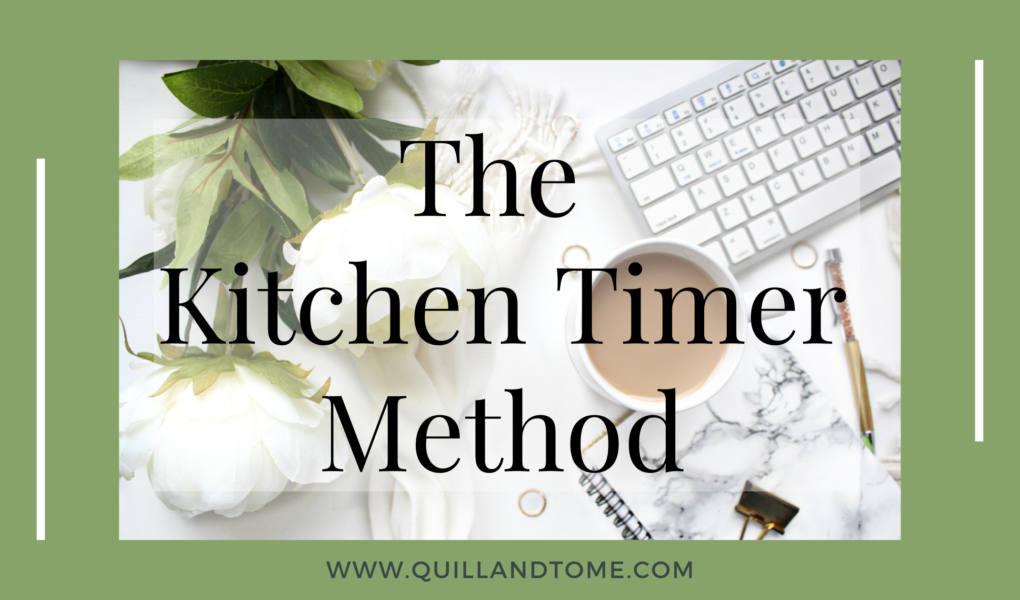The Kitchen Timer Method
A few weeks ago, I finished Talking as Fast as I Can, by Lauren Graham. It was the second book on my TBR list for the month, and let’s just say that I was not disappointed. There were so many interesting things about her writing process and life as an actress, I often found myself laughing out loud.
I have been a fan of Gilmore Girls since I was a young teenager, and it has followed me into adulthood and motherhood. My mom, my sister, and even my daughter are now all fans of the famous Rory, Lorelai, and Emily.
So when Lauren Graham’s memoir came out, I just had to read it. However, it took me TWO YEARS to get around to it.
I almost wish I had read it sooner, but it might not have had the same impact on my professional life. Back then, I had just started writing professionally, and really was just doing it in my spare time. I didn’t think it would take off like it has, and I certainly never expected to make a career out of it. I would have paid attention to the parts of the book where she talks about her writing process, but I may not have taken them to heart.
Lauren Graham is a wonderful actress, and surprisingly a wonderful writer as well! It gives me heart to know that not only writer-writers have trouble writing, but so do actor-writers! Reading her book now has given me the excuse to focus on four pages in the book. Not that I didn’t love the entire thing, but as a writer, these four pages are what stuck out.
She says that the key to her writing process comes from Don Roos, and what he calls the Kitchen Timer Method. I am going to write out the entire thing for you here, with some of my own commentary in between, because why not? The Kitchen Timer Method is not unlike other methods we have all heard. It is even not unlike methods we have discussed on this blog, but it is definitely worth mentioning.
Okay, so here goes:
“The principle of the Kitchen Timer is that every writer deserves a definite and doable way of being and feeling successful every day.
“To do this, we learn to judge ourselves on behavior rather than content. We set up a goal for ourselves as writers that is easy, measurable, free of anxiety, and, above all, fail proof, because everyone can sit, and an hour will always pass.
“Here’s How It Works:
1. Buy a kitchen timer, one that goes to 60 minutes. Or use a timer app. Or tell Siri to start a timer for 60 minutes.
Really, this can be any length of time. 20 minutes, 30, two hours, whatever you have available.
2. We decide on Monday how many hours of writing we will do Tuesday. When in doubt or under pressure or self-attack, we choose fewer hours rather than more. A good, strong beginning is one hour a day, but a half hour is also good, or twenty minutes. Some of us make appointments in our calendar for these hours, as if they are lunch meetings or business calls.
If an hour is intimidating, you can always start off with a shorter amount of time and work your way up to an hour.
3. The Kitchen Timer Hour:
-No phones. No texts. We silence ringers; we turn our phones facedown. It is our life; we are entitled to one hour without interruption, particularly from loved ones. We ask for their support. “I was on an hour” is something they learn to understand. But they won’t respect it unless we do first.
-No music with words, unless it’s a language we don’t understand. Headphones with a white noise app can be helpful.
-No Internet, absolutely. We turn off our computer’s Wi-Fi.
-No reading.
-No pencil sharpening, desk tidying, organizing.
Coming to your writing session prepared always helps you stay focused. Make sure you have plenty of paper and ink or that your laptop is charged. Personally, I have never been one to be able to write while music is playing, but I have to work really hard to not get distracted by my phone or book. Usually, I leave them on the counter where I actually have to get up to check on them.
- Immediately upon beginning the hour, we open two documents: our journal, and the project we are working on. If we don’t have a project we’re actively working on, we just open our journal.
- An hour consists of TIME SPENT KEEPING OUR WRITING APPOINTMENT. That’s it. We don’t have to write at all, if we are happy to stare at the screen or the page. Nor do we have to write a single word on our current project; we may spend the entire hour writing in our journal. Anything we write in our journal is fine; ideas for future projects, complaints about loved ones, what we ate for dinner, even “I hate writing” typed four hundred times.
When we wish or if we wish, we pop over to the current project document and write for as long as we like. When we get tired or want a break, we pop back to the journal.
The point is, when disgust or fatigue with the current project arises, we don’t take a break by getting up from our desk. We take a break by returning to the comforting arms of our journal, until that in turn bores us. Then we are ready to write on our project again, and so on. We use our boredom in this way.
IT IS ALWAYS OKAY TO WRITE EXCLUSIVELY IN OUT JOURNAL. In practice it may rarely happen that we spend the full hour in our journal, but it’s fine, good, and right if it does. It is just as good a writing day as one spent entirely in our current project.
- It is infinitely better to write fewer hours every day than many hours one day and none the next. If we have a crowded weekend, we choose a half or quarter hour as our time, put in that time, and go on with our day. We are always trying to minimize our resistance, and beginning an hour on Monday after two days off is a challenge.
- When the hour is up, we stop, even if we’re in the middle of the sentence. If we have scheduled another hour, we give ourselves a break before beginning again–to read, eat, go on errands. We are not trying to create a cocoon we must stay in between hours (the old “I’m sorry, I can’t see anyone or leave my house–I’m on a deadline” method). Rather, inside the hour is the inviolate time.
- If we fail to make our hours for the day, we have scheduled too many. Four hours a day is an enormous amount of time spent in this manner, for example. If on Wednesday we planned to write two hours and didn’t make it, we schedule a shorter appointment for the next day. We don’t add an hour to “make up” or “catch up.” We let the past go and move on.
- When we have fulfilled our commitment, we make sure we credit ourselves for doing so. We have satisfied our obligation to ourselves, and the rest of the day is ours to do with as we wish.
- A word about content: This may seem to be all about form, but the knowledge that we have satisfied our commitment to ourselves, the freedom from anxiety and resistance, the stilling of that hectoring voice inside us that used to yell at us that we weren’t writing enough–all this opens us up creatively.
Good luck!
Don Roos”
CHECK OUT THE WRITER’S PLANNER BY QUILL AND TOME!
Get the planner and organize your life and your writing!
What you can find inside:
- Plenty of writing space in a vertical layout
- Undated weekly and monthly pages you can start using any day of the year
- Reading and Writing Trackers
- Writing Tips
- and so much more!
I have to say, that I have been using this method ever since I finished Talking as Fast as I Can, and I have been consistently more productive than I have in a long time. Sitting down every day with my journal AND my WIP has helped me actually make some progress and establish a routine. I feel weird if I don’t at least write something in my journal.
Over To You
Hopefully, you found this helpful.
If you have a writing method that works for you, please tell us about it below!
If you enjoyed this content and are interested in fitting writing into your daily life, DOWNLOAD THE FREE WORKBOOK! Read our monthly newsletter, full of valuable writing advice and be the first to know when we release a new product or book.





